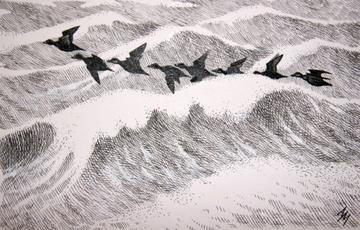Common Scoter (Melanitta nigra)

Common Scoter © Andrew Mart
We now know that the Common Scoters seen from the north Wirral shore, often at the limits of telescope vision even for dedicated sea-watchers, are just a small part of the vast concentrations in Liverpool Bay. Aerial survey work since 2000/ 01 has shown that an average of 51,000 Common Scoters spend the winter in the Irish Sea between the north Wales coast and the Solway Firth, the biggest gathering anywhere in Britain (Banks et al 2006). Their main concentrations are on the Shell Flat, offshore from Blackpool, and in Colwyn Bay, but another important wintering site is off the North Wirral coast, an area roughly 4 km in diameter centred just over 3 km northwest of Meols, shown in the map of the aerial survey results. Almost all these birds are within the 10 m water depth contour where they dive to find molluscs, mainly mussels, on the sandy sea-bed.
Unfortunately, these surveys have been triggered by the potential threats to scoters from the construction of offshore windfarms: it is this species’ misfortune to favour the shallow sandbanks that are also the preferred construction sites for turbines. However, the new awareness of the importance of this area has prompted consideration of all of the important areas of Liverpool Bay, including those off the North Wirral, as a marine Special Protection Area.
For such a marine species, the flocks that came close enough inshore to be recorded for this Atlas are the ‘tip of the iceberg’. The largest counts submitted were 43 off Hilbre (SJ18Y and SJ18Z), 190 and 150 off Hoylake shore (SJ29A and SJ29E respectively) and 80 birds offshore from Meols (SJ29F and SJ29G). Much easier to see, and much less common, was the only inland record during this Atlas, a female at Arclid SQ (SJ76W) on 11 January 2005.
The distribution of Common Scoters in the county has most likely not changed for centuries. Byerley (1856) knew it as ‘very abundant about the sandbanks’ and Brockholes (1874) wrote that it was ‘an abundant duck at sea off the north of Wirral’. It seems that this is one species for which Coward (1910) probably got it wrong. He wrote that ‘during the winter months the Common Scoter occurs in considerable numbers in the Dee and Mersey estuaries’ although he added that ‘as a rule the scoter does not ascend the estuaries to any great distance’, and noted that the shallow waters near Hilbre were their favourite feeding grounds. Birds had been noticed occasionally on inland waters, but most of the records listed are at passage times. Bell (1962) remarked that Coward’s description would not fit the 20th century picture, with no indication of large estuarine flocks. They were still common in the Dee estuary and could be seen in all months, but numbers in the 1950s rarely exceeded 40 birds. Inland records were almost annual in very small numbers.
Since then, Cheshire and Wirral Bird Reports confirm the status at the mouth of the Dee and north Wirral coasts. Mersey records are very unusual, as are inland birds in winter, with only about three records in the last decade. The Atlas map, therefore, gives a reasonable snapshot of the species’ distribution.
Sponsored by Liverpool University Press

